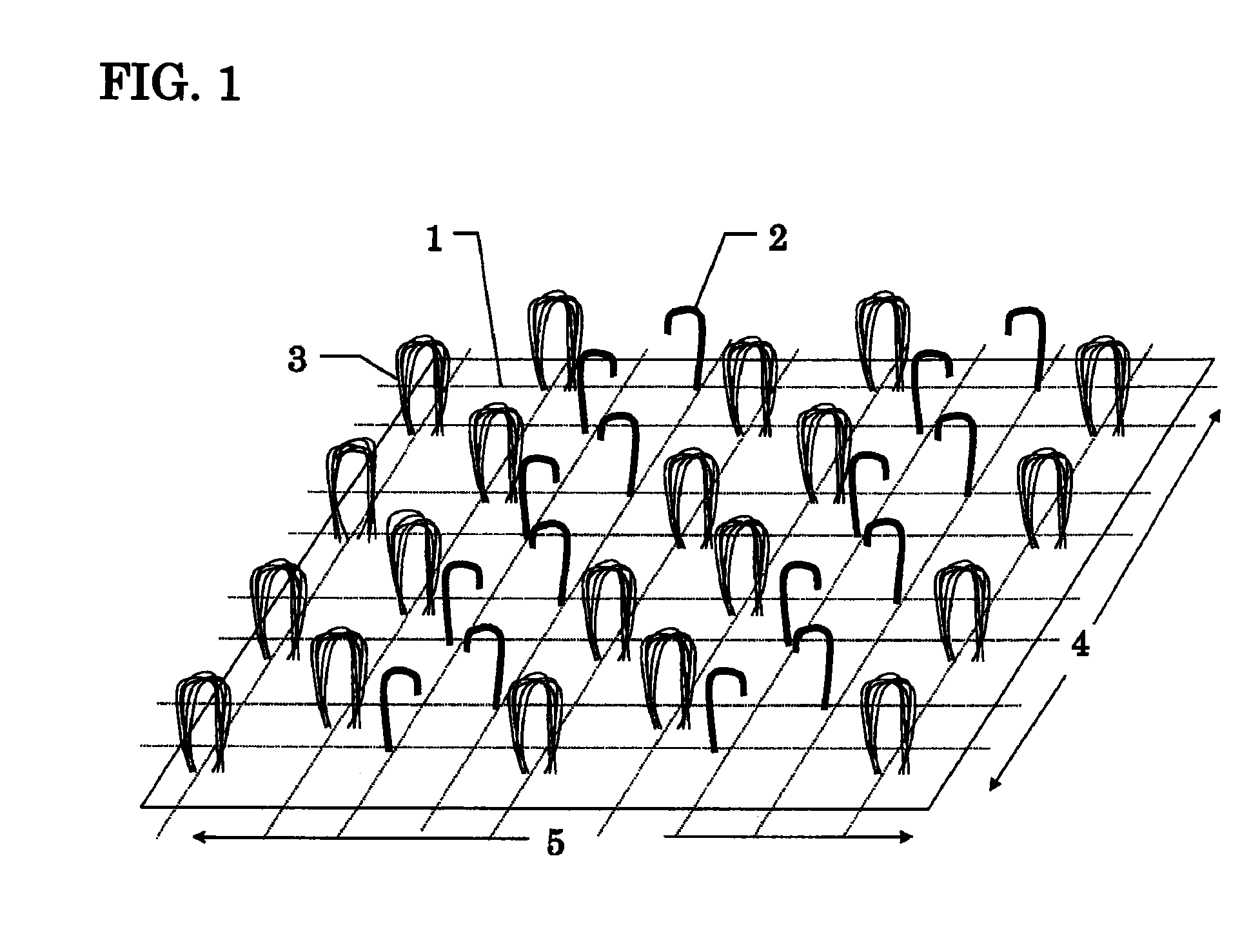Surface fastener and surface fastener latch element combination
a surface fastener and latch element technology, applied in the direction of snap fasteners, buckles, protective garments, etc., can solve the problems of affecting the quality and high-grade appearance of the product to which a surface fastener is attached, polyamide fibers, and polyamide fibers, etc., to achieve good durability, high engagement strength, and the effect of the same dyeability
- Summary
- Abstract
- Description
- Claims
- Application Information
AI Technical Summary
Benefits of technology
Problems solved by technology
Method used
Image
Examples
example 1
[0092]The following warp yarn and weft yarn were used for forming the base fabric of surface fastener, the following monofilament was used for forming the hook fastener element, and the following multifilament was used for forming the loop fastener element.
Warp Yarn
[0093]Multifilament yarn made from polyethylene terephthalate having a melting point of 260° C.[0094]Total fineness: 167 dtex[0095]Number of filaments: 30
[0096]Heat fusible multifilament yarn made of sheath-core composite fibers.[0097]Core component: polyethylene terephthalate (melting point: 260° C.)[0098]Sheath component: polyethylene terephthalate copolymerized with 25 mol % isophthalic acid (softening point: 190° C.)[0099]Sheath-core ratio (by weight): 70:30[0100]Total fineness: 99 dtex[0101]Number of filaments: 24[0102]Dry heat shrinkage at 200° C.: 13%
Monofilament for Hook Fastener Element
[0103]Polyethylene terephthalate fiber (melting point: 260° C.)[0104]Fineness: 390 dtex (diameter: 0.19 mm)
Multifilament...
example 2
[0127]A hook surface fastener (A) was produced in the same manner as in Example 1 except for changing the fineness of the monofilament made from polyethylene terephthalate to 300 dtex (diameter: 0.17 mm). The obtained hook surface fastener (A) and the loop surface fastener (B) obtained in Example 1 were engaged with each other and measured for the engagement strength. The results are shown in Table 2.
[0128]As seen from Table 2, the engagement strength of the surface fastener combination of Example 2 was slightly lower than that of Example 1, but much higher than those of the above comparative examples. Like the surface fasteners of Example 1, the change in shape, such as waving, was not found after immersing in water. As compared with the commercially available combinations of surface fastener fabrics which are coated with a back coat resin, the base fabric of Example 2 was extremely soft and suitable for clothing applications.
example 3
[0129]A loop surface fastener (B) was produced in the same manner as in Example 1 except for using a multifilament for loop fastener elements made from polybutylene terephthalate (total fineness: 265 dtex, number of filaments: 10) to form the loop fastener elements. The obtained loop surface fastener (B) and the hook surface fastener (A) obtained in Example 1 were engaged with each other and measured for the engagement strength. The results are shown in Table 2.
[0130]As seen from Table 2, the surface fastener combination of this example had the initial engagement strength higher than that of Example 1, but reduced in the engagement strength after repeating engagement and disengagement 5000 times. The initial engagement strength was extremely higher than those of the above comparative examples. The observation on the loop fastener elements after repeating engagement and disengagement 5000 times showed that a considerable number of multifilaments forming the loop fastener elements wer...
PUM
| Property | Measurement | Unit |
|---|---|---|
| diameter | aaaaa | aaaaa |
| diameter | aaaaa | aaaaa |
| height | aaaaa | aaaaa |
Abstract
Description
Claims
Application Information
 Login to View More
Login to View More - R&D
- Intellectual Property
- Life Sciences
- Materials
- Tech Scout
- Unparalleled Data Quality
- Higher Quality Content
- 60% Fewer Hallucinations
Browse by: Latest US Patents, China's latest patents, Technical Efficacy Thesaurus, Application Domain, Technology Topic, Popular Technical Reports.
© 2025 PatSnap. All rights reserved.Legal|Privacy policy|Modern Slavery Act Transparency Statement|Sitemap|About US| Contact US: help@patsnap.com


